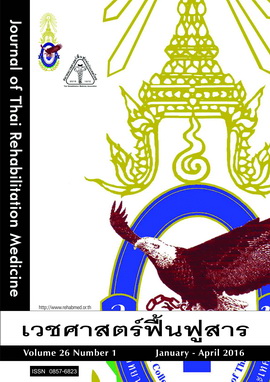ความชุกของโรคไฟโบรมัยอัลเจียในผู้ป่วยนอกที่มารับบริการ ตรวจรักษา ณ กองเวชศาสตร์ฟื้นฟู โรงพยาบาลพระมงกุฎเกล้า
ความชุกของโรคไฟโบรมัยอัลเจียในผู้ป่วยนอกที่มารับบริการ ตรวจรักษา ณ กองเวชศาสตร์ฟื้นฟู โรงพยาบาลพระมงกุฎเกล้า
Keywords:
fibromyalgia, prevalence, pain, quality of life, โรคไฟโบรมัยอัลเจีย, ความชุก, อาการปวด, คุณภาพชีวิตAbstract
ABSTRACT
Objectives: To determine the prevalence of fibromyalgia,and compare demographic data, symptom characteristics,and quality of life (QOL) between fibromyalgia group andgroup of other causes of pain.
Study design: Cross-sectional descriptive study.
Setting: The Physical Medicine and Rehabilitation (PMR) outpatient clinic in Phramongkutklao Hospital.
Subjects: Four hundred and forty-seven out-patients from February to August 2013.
Methods: Data were collected by direct semi-structured interview including patients’ characteristics, the 2010 American College of Rheumatology preliminary diagnostic criteria for fibromyalgia, and the Thai version of SF-36 (version 2) questionnaire, then the prevalence of fibromyalgia was estimated, and the demographic data, symptom characteristics, and QOL between fibromyalgia group and group of other causes of pain were compared.
Results: There were 15 patients (3.4%) fulfilling the fibromyalgia criteria, with female predominance (93.33%). The mean (standard deviation) pain score, widespread pain index, and symptom severity scale score of the patients with fibromyalgia were 6.67 (1.35), 10.53 (3.46), and 8.40 (1.80), respectively, which were significantly higher (p < 0.05) than those of the patients in other groups. The fibromyalgia patients also ranked significantly lower in all domains of QOL compared with the group of other causes of pain (p < 0.05).
Conclusion: At the PMR outpatient clinic, the prevalenceof fibromyalgia was 3.4%, lower than other causes of
pain. Pain and other symptoms were more severe whereas quality of life was lower in patients with fibromyalgia and patients with other causes of pain.
References
2. Bannwarth B, Blotman F, Roué-Le Lay K, Caubère JP, André E, Taïeb C. Fibromyalgia syndrome in the general population of France: a prevalence study. Joint Bone Spine 2009; 76: 184-7.
3. Branco JC, Bannwarth B, Failde I, AbelloCarbonell J, Blotman F, Spaeth M, et al. Prevalence of fibromyalgia: A Survey in five European Countries. Semin Arthritis Rheum 2010; 39: 448-53.
4. Topbas M, Cakirbay H, Gulec H, Akgol E, Ak I, Can G. The prevalence of fibromyalgia in women aged 20-64 in Turkey. Scand J Rheumatol 2005; 34: 140-4.
5. Andary MT, Wieting JM, Baer D, Naftulin S, Hallgren RC. The prevalence of fibromyalgia in collegiate athletes. J Clin Rheumatol 2004; 10: 323-5.
6. Wolfe F. Fibromyalgia: the clinical syndrome. Rheum Dis Clin North Am 1989; 15: 1-18.
7. Wolfe F, Ross K, Anderson J, Russell IJ, Hebert L. The prevalence and characteristics of fibromyalgia in the general population. Arthritis Rheum 1995; 38: 19-28.
8. M. S. Dokwe, G. Omondioyoo, E. O. Amayo. Prevalence of Fibromyalgia at the Medical out Patient Clinic. Kenyatta National Hospital. East Afr Med J 2011; 88: 155-62.
9. Brill S, Ablin JN, Goor-Aryeh I, Hyat K, Slefer A, Buskila D; Tel Aviv-Sourasky Medical Center. Prevalence of fibromyalgia syndrome in patients referred to a tertiary pain clinic. J Investig Med. 2012; 60: 685-8.
10. Wolfe F, Clauw DJ, Fitzcharles MA, Goldenberg DL, Katz RS, Mease P, et al. The American College of Rheumatology preliminary diagnostic criteria for fibromyalgia and measurement of symptom severity. Arthritis Care Res (Hoboken) 2010; 62: 600-10.
11. Annemans L, Wessely S, Spaepen E, Caekelbergh K, Caubère JP, Le Lay K, Taïeb C. Health economic consequences related to the diagnosis of fibromyalgia syndrome. Arthritis Rheum. 2008; 58: 895-902.
12. Hoffman DL, Dukes EM. The health status burden of people with fibromyalgia: a review of studies that assessed health status with the SF-36 or the SF-12. Int J ClinPract. 2008; 62: 115-26.
13. Prateepavanich P, Aromdee E, Chaudakshetrin P, Laurujisawat P, Poungvarin N, Leartsakulpanitch J, et al. Modifications of the American College of Rheumatology 2010 Preliminary
Diagnostic Criteria for Fibromyalgia Syndrome and Measurement of Symptom Severity as a Screening Tool for its Diagnosis [ACR 2010 FMS-STD]: Lessons Learned from the Process of Translation and Validation into a Thai Version. Journal of Musculoskeletal Pain [Internet]. 2014 Feb [cited 2014 Feb 04];22(1):7-12. Available from: http://www.tandfonline. com/doi/full/10.3109/10582452.2014.883014
14. Jirarattanaphochai K, Jung S, Sumananont C, Saengnipanthkul S. Reliability of the medical outcomes study short-form survey version 2.0 (Thai version) for the evaluation of low back pain patients. J Med Assoc Thai 2005; 88: 1355-61.
15. Ware JE. SF-36® Health Survey Update [Internet]. Lincoln: Quality Metric Incorporated; 2003 [cited 2013 Jun 30]. Available from: http://www.sf-36.org/tools/sf36.shtml
16. ธนกรณ์ งามเชวง, ดุจใจ ชัยวานิชศิริ. คุณภาพชีวิตภายหลังการฟื้นฟู สมรรถภาพหัวใจของผู้ป่วยที่ได้รับการผ่าตัดหลอดเลือดหัวใจ (CABG) ณ โรงพยาบาลจุฬาลงกรณ์. เวชศาสตร์ฟื้นฟูสาร 2544; 10(3): 107-116.
17. Wolfe F, Michaud K. Severe rheumatoid arthritis (RA), worse outcomes, comorbid illness, and sociodemographic disadvantage characterize RA patients with fibromyalgia. J Rheumatol 2004; 31: 695–700.
18. Castro-Sánchez AM, Matarán-Peñarrocha GA, López- Rodríguez MM, Lara-Palomo IC, Arendt-Nielsen L, Fernández-de-las-Peñas C. Gender differences in pain severity, disability, depression, and widespread pressure pain sensitivity in patients with fibromyalgia syndrome without co-morbid conditions. Pain Med 2012; 13: 1639-47.
19. Riley JL, Robinson ME, Wise EA, Myers CD, Fillingim RB. Sex differences in the perception of noxious experimental stimuli: a meta-analysis. Pain 1998; 74: 181–7.
20. Peleg R, Ablin JN, Peleg A, Neumann L, Rabia RA, Buskila D. Characteristics of fibromyalgia in Muslim Bedouin women in a primary care clinic. Semin Arthritis Rheum. 2008; 37: 398-402.
21. Santos AM, Burti JS, Lopes JB, Scazufca M, Marques AP, Pereira RM. Prevalence of fibromyalgia and chronic widespread pain in community-dwelling elderly subjects living in São Paulo, Brazil. Maturitas. 2010; 67: 251-5.
22. Janwantanakul P, Pensri P, Jiamjarasrangsri V, Sinsongsook T. Prevalence of self-reported musculoskeletal symptoms among office workers. Occup Med (Lond). 2008; 58: 436-8.
23. Usui C, Hatta K, Aratani S, Yagishita N, Nishioka K, Kanazawa T, et al. The Japanese version of the modified ACR Preliminary Diagnostic Criteria for Fibromyalgia and the Fibromyalgia Symptom Scale: reliability and validity. Mod Rheumatol 2013; 23: 846-50.






